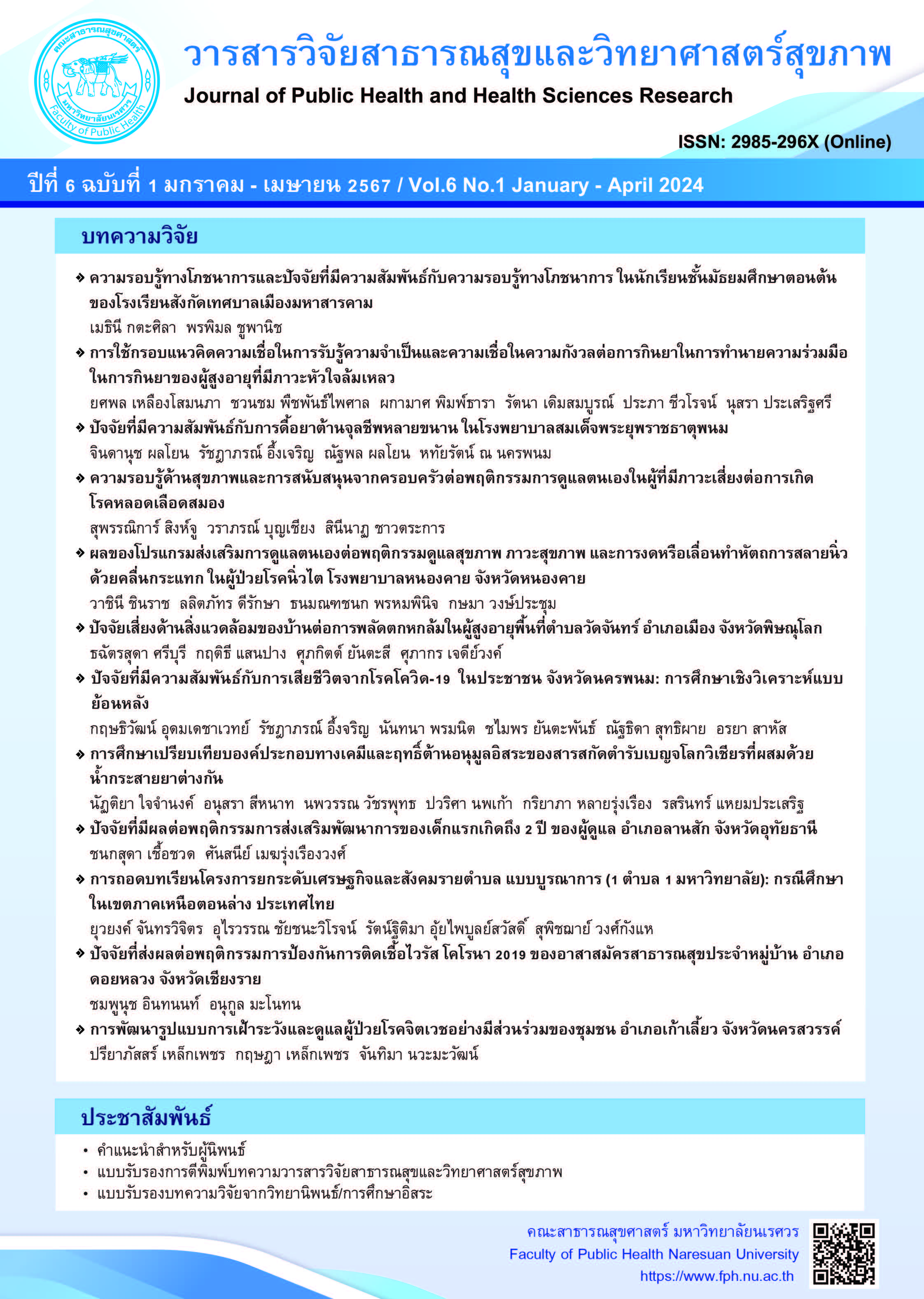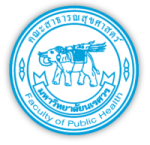Factors associated with multidrug resistance at Thatphanom Crown Prince Hospital
Keywords:
Multidrug resistance, Risk factors, Community hospitalAbstract
Multidrug resistance (MDR) is an important public health problem nowadays. This research involves a retrospective case-control study. The objective of this study is to investigate the risk factors associated with MDR infections among inpatients at Thatphanom Crown Prince Hospital from 1 January 2016 to 31 December 2020. Binary logistic regression was used to analyze the risk factors for MDR.
The study revealed MDR patients accounted for 28.28% of all. The majority of MDR patients were aged over 60 years. The most common MDR was Escherichia coli. Furthermore, the risk factors for MDR were as follows: the presence of smoking history (ORAdj 1.38, 95% CI = 1.08-1.74), drinking history (ORAdj 1.27, 95% CI = 1.02-1.58), urinary tract infection (ORAdj 2.84, 95% CI = 2.19 - 3.67), gram-negative bacterial infection (ORAdj 2.99, 95% CI = 2.28-3.91), steroid usage in the past 90 days (ORAdj 1.87, 95% CI = 1.40-2.51), urinary catheter usage in the past 90 days (ORAdj 1.64, 95% CI 1.25 - 2.17) and a length of hospitalization exceedingseven days (ORAdj 1.44, 95% CI = 1.16-1.81). Therefore, the hospital should utilize the factors obtained from this study to generate policies and prevention guidelines for MDR in order to control and reduce the spread of MDR more effectively.
References
Abdelmalek, S. M. A., Alhadad, S., Abu-Omar, O., Afaneh, M., Abu-Qatouseh, L., & Collier, P. J. (2022). The effect of cigarette smoke condensate (CSC) on Pseudomonas aeruginosa virulence and antibiotic sensitivity. Journal of applied microbiology, 132(5), 3951-3958. https://doi.org/10.1111/jam.15501
Amanati, A., Sajedianfard, S., Khajeh, S., Ghasempour, S., Mehrangiz, S., Nematolahi, S., & Shahhosein, Z. (2021). Bloodstream infections in adult patients with malignancy, epidemiology, microbiology, and risk factors associated with mortality and multi-drug resistance. BMC infectious diseases, 21(1), 636. https://doi:10.1186/s12879-021-06243-z
Antimicrobial Resistance Collaborators. (2022). Global burden of bacterial antimicrobial resistance in 2019: a systematic analysis. Lancet (London, England), 399(10325), 629–655. https://doi.org/10.1016/S0140-6736(21)02724-0
Boonlum, S. (2021). Risk Factors of the Multidrugresistant in Surgical II Intensive Care Unit, Suratthani Hospital. Journal of Health Sciences and Pedagogy, 1(1), 28-39. (in Thai)
Centers for Disease Control Prevention. (2019, December). Antibiotic resistance threats in the United States, 2019. Retrieved December 20, 2021, from www.cdc.gov/DrugResistance/Biggest-Threats.html
Chara, C., Khemla, S., Pholhemhan, S., Surin, U., & Prasert, K. (2016). Risk factors associated with antibiotic multidrug resistant nosocomial infection among hospitalized patients aged 14 years and older in Nakhon Phanom Hospital. Nakhon Phanom Hosp J, 6(1), 6-17. (in Thai)
Chomjan, T., & Singto, P. (2022). Multipleantimicrobial resistance (AMR) of patients in internal dedicine department. APHEIT Journal of Nursing and Health, 4(3), 1-16. (in Thai)
Chomkerd, T., Phanpanich, W., & Menaphol, S. (2019). Histological alterations of the urinary tract infection by Escherichia coli from urinary catheter. Srinagarind Medical Journal, 34(4), 406-413. (in Thai)
Chopjitt, P., Putthanachote, N., Sangsa, N., Sirisa, P., Chinnakarnsawas, S., Kankang, C., et al. (2021). Factors associated with multidrugresistant Pseudomonas aeruginosa infection: a hospital-based case-control study. Archives of Allied Health Sciences, 33(2), 48-55.
Chungsamanukool, P. (2022). Incidence, risk factors, mortality rate, and impact of multidrugresistant gram-negative bloodstream Infections in Photharam hospital. Region 4-5 Medical Journal 41(1), 579-592. (in Thai)
Clinical and Laboratory Standards Institute. (2021). Performance standards for antimicrobial susceptibility testing (31st ed.): CLSI supplement M100. Clinical and Laboratory Standards Institute.
Dessie, T., Jemal, M., Maru, M., & Tiruneh, M. (2021). Multiresistant bacterial pathogens causing bacterial pneumonia and analyses of potential risk factors from northeast Ethiopia. International Journal of Microbiology, 2021, 6680343. https://doi: 10.1155/2021/6680343
Falcone, M., Tiseo, G., Dentali, F., La Regina, M., Foglia, E., Gambacorta, M., et al. (2018). Predicting resistant etiology in hospitalized patients with blood cultures positive for Gram-negative bacilli. European journal of internal medicine, 53, 21-28. https://doi:10.1016/j.ejim.2018.01.029
Gomila, A., Shaw, E., Carratala, J., Leibovici, L., Tebe, C., Wiegand, I., et al. (2018). Predictive factors for multidrug-resistant gram-negative bacteria among hospitalised patients with complicated urinary tract infections. Antimicrob Resist Infect Control, 7, 111: https://doi: 10.1186/s13756-018-0401-6
Health Systems Research Institute Coordination and Integration Committee on Antimicrobial Resistance. (2017, December). Thailand national strategic plan on antimicrobial resistance 2017-2021 [online]. Retrieved April 15, 2023, from https://rr-asia.woah.org/wp-content/uploads/2020/03/thailand_thailands-national-strategic-plan-on-amr-2017-2021.pdf (in Thai)
Juylek, N., Picheansathian, W., & Kasatpibal, N. (2016). Development of risk factor scoring system of multidrug-resistant microorganism infection among in-patients. Nursing Journal CMU, 43(3), 69-80. (in Thai)
Kakoullis, L., Papachristodoulou, E., Chra, P., & Panos, G. (2021). Mechanisms of antibiotic resistance in important gram-positive and gram-negative pathogens and novel antibiotic solutions. Antibiotics, 10(4), 415.
Laboratory Department Thatphanom Crown Prince Hospital. (2020). Annual examination report.Nakhon Phnom: Thatphanom Crown Prince Hospital. (in Thai)
Nakhonphanom Provincial Health Office. (2019). Annual report on antimicrobial susceptibility results in Nakhon Phanom Province. Nakhon Phnom: Nakhonphanom Provincial Health Office. (in Thai)
Nakhonphanom Provincial Health Office. (2021, September 30). Summary of problems from the inspection and recommendations of a grocery store selling health products in Nakhon Phanom Province in 2021. Retrieved April 20, 2023, from https://www.nkp-ossc.net (in Thai)
Nakonchai, T. (2018). Factors associated with multi drug resistant infections among patients of Udonthani cancer hospital. Nursing, Health, and Education Journal, 1(1), 23-30. (in Thai)
National Antimicrobial Resistance Surveillance Thailand. (2019). Global and national antimicrobial resistance situation 2019. Retrieved December 20, 2021, from http://narst.dmsc.moph.go.th/
Phodha, T., Riewpaiboon, A., Malathum, K., & Coyte, P. C. (2019). Excess annual economic burdens from nosocomial infections caused by multi-drug resistant bacteria in Thailand. Expert Rev Pharmacoecon Outcomes Res, 19(3), 305-312. https://doi:10.1080/14737167.2019.1537123
Ponyon, J., Kerdsin, A., Preeprem, T., & Ungcharoen, R. (2022). Risk factors of infections due to multidrug-resistant gram-negative bacteria in a community hospital in rural Thailand. Tropical Medicine and Infectious Disease, 7(11). https://doi:10.3390/tropicalmed7110328
Ponyon, J., & Ungcharoen, R. (2023). Incidence of multidrug-resistant gram-negative bacteria in blood specimens in a community hospital in northeast. Thai Journal of Pharmacy Practice, 15(1), 96-109. (in Thai)
Punchuey, S. (2023). Do the benefits of systemic corticosteroids outweigh adverse effects. Krabi Medical Journal, 5(2), 71-91. (in Thai)
Rafailidis, P. I., & Kofteridis, D. (2022). Proposed amendments regarding the definitions of multidrug-resistant and extensively drug-resistant bacteria. Expert Review of Anti-infective Therapy, 20(2), 139-146. https:// doi:10.1080/14787210.2021.1945922
Ruayajin, N., Chomjan, T., & Singto, P. (2022). The outcomes of using anti-AMR guideline to prevent the spread of drug-resistant organisms infections. Singburi Hospital Journal, 31(1), 27-40. (in Thai)
Thai health codig center. (2015, May 29). Number of hospitals classified by type (public and private). Retrieved December 20, 2021, fromhttp://thcc.or.th/download/Number%20of%20hospital%20290558.pdf
Thammatacharee N., Tomacha N., & Pannarunothai S. (2022). Advocacy on rational drug use policy in Thailand. Journal of Health Systems Research,16(3), 281-288. (in Thai)
Viasus, D., Puerta-Alcalde, P., Cardozo, C., Suarez- Lledo, M., Rodriguez-Nunez, O., Morata, L., et al. (2020). Predictors of multidrug-resistant Pseudomonas aeruginosa in neutropenic patients with bloodstream infection. Clinical Microbiology and Infection, 26(3), 345-350. https://doi:10.1016/j.cmi.2019.07.002
Yingkhajorn, S., Sutthichot, S., Hongthong, N., Boonrod, T., Simla, W., & Sriraksa, S. (2021). Occurrence of antimicrobial resistance in hospital: A systematic review and meta-analysis. Journal of Health Science, 30(5), 916-927.
Downloads
Published
How to Cite
Issue
Section
License
Copyright (c) 2024 Journal of Public Health and Health Sciences Research

This work is licensed under a Creative Commons Attribution-NonCommercial-NoDerivatives 4.0 International License.
The published article is copyrighted by the Journal of Public Health and Health Sciences Research.
The statements that appear in each article in this academic and research journal are the personal opinions of each author and are not related to Naresuan University and other faculty members in the university. Responsibilities regarding each article are the responsibility of each author.






